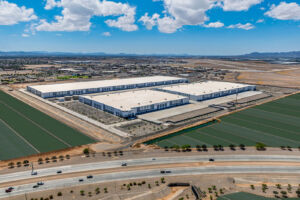This year, America’s overall infrastructure was awarded a D+ grade, according to the American Society of Civil Engineers’ “Infrastructure Report Card.” Arizona’s infrastructure may be relatively newer by comparison but it is starting to show signs of wear and tear as indicated by the C grade that it received from ASEC.
While the state of Arizona’s infrastructure may not be in as dire of shape as other urban areas, the need for new and repaired infrastructure is widely talked about, especially at Valley Partnership.
For 30 years now, Valley Partnership has been the rational voice at the table whenever important policy issues such as infrastructure needs are being discussed whether it’s transportation, aviation, dams, bridges, railways or any of the state’s other infrastructure systems, most of which received C grades or lower in the ASEC report.
“While we can identify many areas that are the biggest concern,” says Jill Kusy Hegardt, vice president of entitlements at DMB Associates, “the true biggest concern is really how to prioritize and fund all the projects that are important to build.”
By the Numbers
Currently, Arizona is not playing with a full deck of cards when it comes to infrastructure funding. The state’s Highway User Revenue Fund, which is funded by revenues such as gas taxes, has not been fully funded for some time now. Associations like Valley Partnership have prioritized a fully funded HURF for the next legislative session.
For Jim Rounds, president of Rounds Consulting Group, it’s a matter of funding, implementation, collaboration and groups like Valley Partnership discussing transportation economics as part of what they do in their everyday work.
He says, “The next chapter in Arizona’s infrastructure story is about spreading awareness and showcasing how infrastructure relates to commerce and economic development,” which is one of Valley Partnership’s specialties.
Because Valley Partnership has such a broad coalition of members, it affords the organization a unique access to resources, research as well as the decision makers and influencers on both the public and private sides of the development community. Once Valley Partnership assesses the points of view and conerns from both sides, it works on strategies to better educate and inform all parties.
Molly Ryan Carson, vice president of development at Ryan Companies, says, “Valley Partnership helps explain the return on investment for infrastructure projects as it relates to overall commerce and economic development impact that’s beneficial for not only the industry, but the cities and state as a whole.”
For example, the proposed construction of Interstate 11 in the West Valley, which would connect metropolitan areas in the United States to Mexico and Canada.
“Aside from the concrete things that it will do,” says Carson, “it will enhance the perception and reality of what you can do as a company in and through Arizona. It makes us a couple fonts larger on everyone’s white papers,” especially site selectors and planners.
Over the next year or two, Rounds would like to see continued education and awareness efforts to show the public the different things that make the economy tick and how effectively managing the state’s limited resources can produce the biggest returns on investment.
“Once you show the public the potential return of investment,” explains Rounds, “they will buy into the big picture plan and be more trusting of how the government is spending their tax dollars.”
For instance, along the 26-mile Valley Metro Rail line there has been nearly $9 billion in economic investment including residential and commercial development since start-up of service in December 2008, says Scott Smith, CEO of Valley Metro.
The planned 66-mile high capacity transit system operated by Valley Metro allows for future growth and mobility as Arizona’s population expands and its communities become denser.
Arizona’s Infrastructure Report Card
“Light rail has been a major contributor to an upward spiral of assets including an expansion of the local arts and culture scene, relocation of businesses who choose to be positioned near rail and the connection to education that supports our overall economy and quality of life,” Smith adds.
Eric Anderson, transportation director of the Maricopa Association of Governments, compares the success of the light rail to new freeways like the Loop 303, which created new access and led to the development of another transportation, employment and commerce corridor in the West Valley. “Light rail does the same thing on the transit side,” he says.
When you have new investments, it means increased tax revenues from sales and property taxes and the areas become more dynamic so people and businesses are attracted to those areas.
“Transportation investments are extremely important to the economic vitality of the region,” explains Anderson, “which is why Valley Partnership and its members are key to our continued success in making investments to transportation.”





